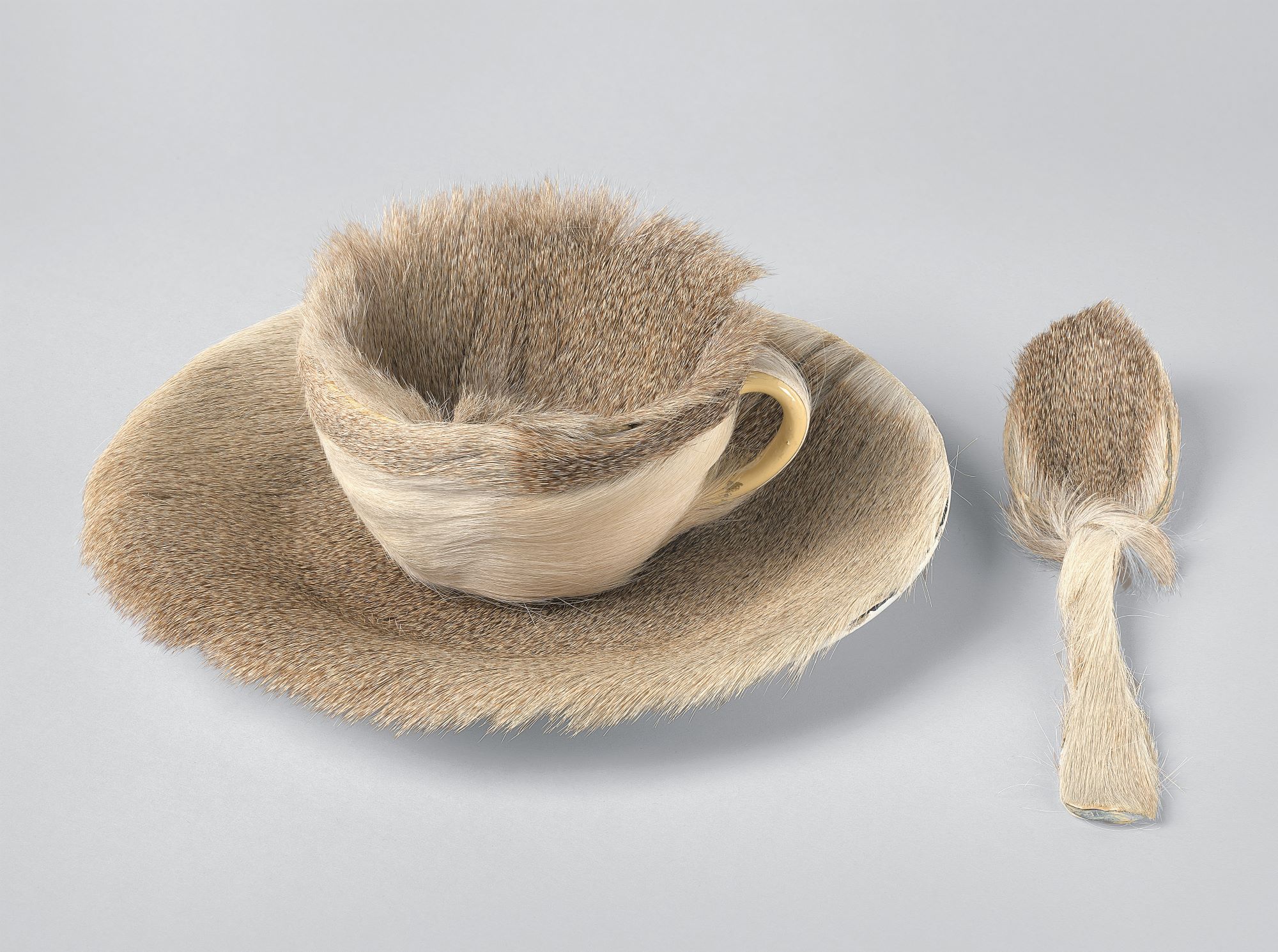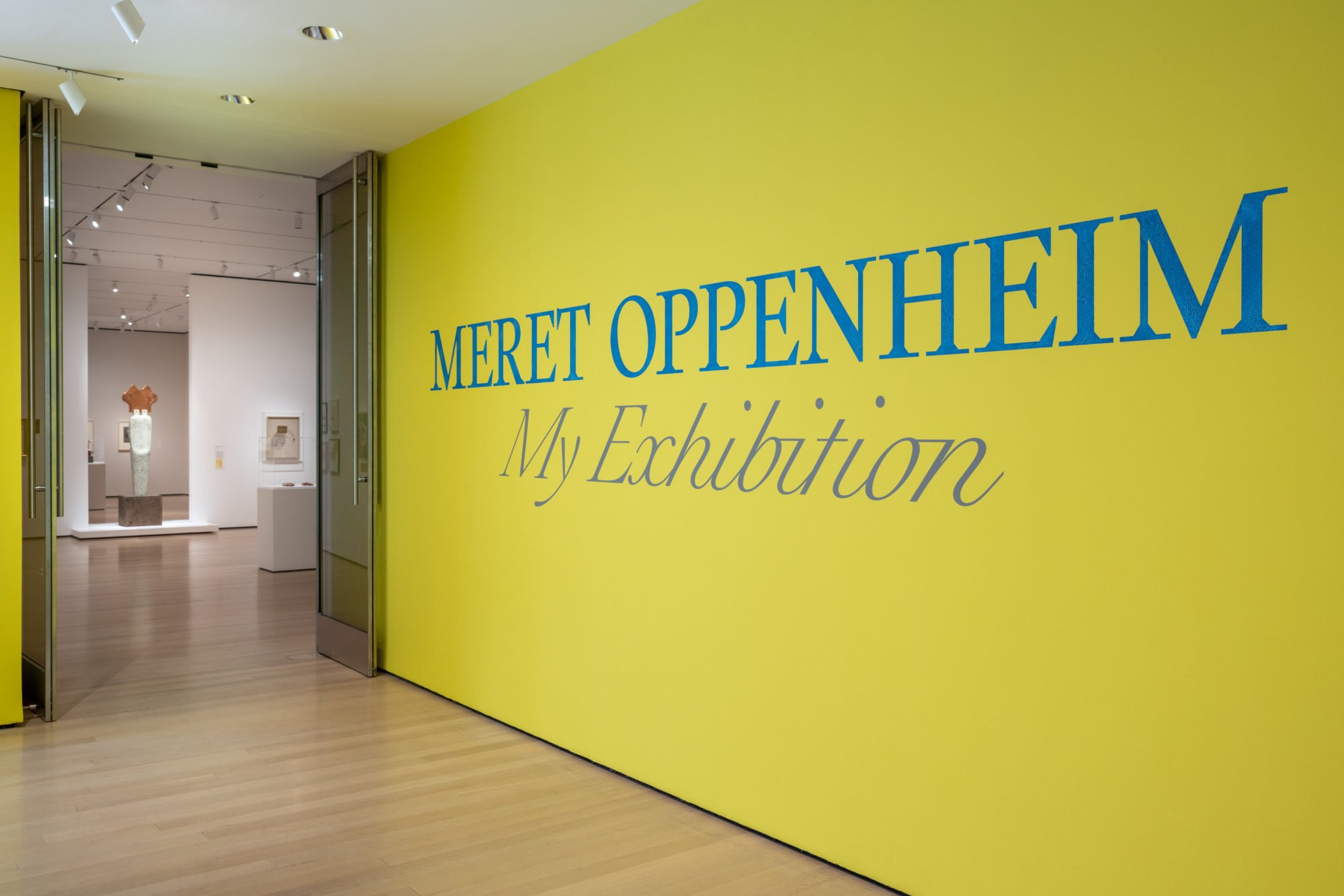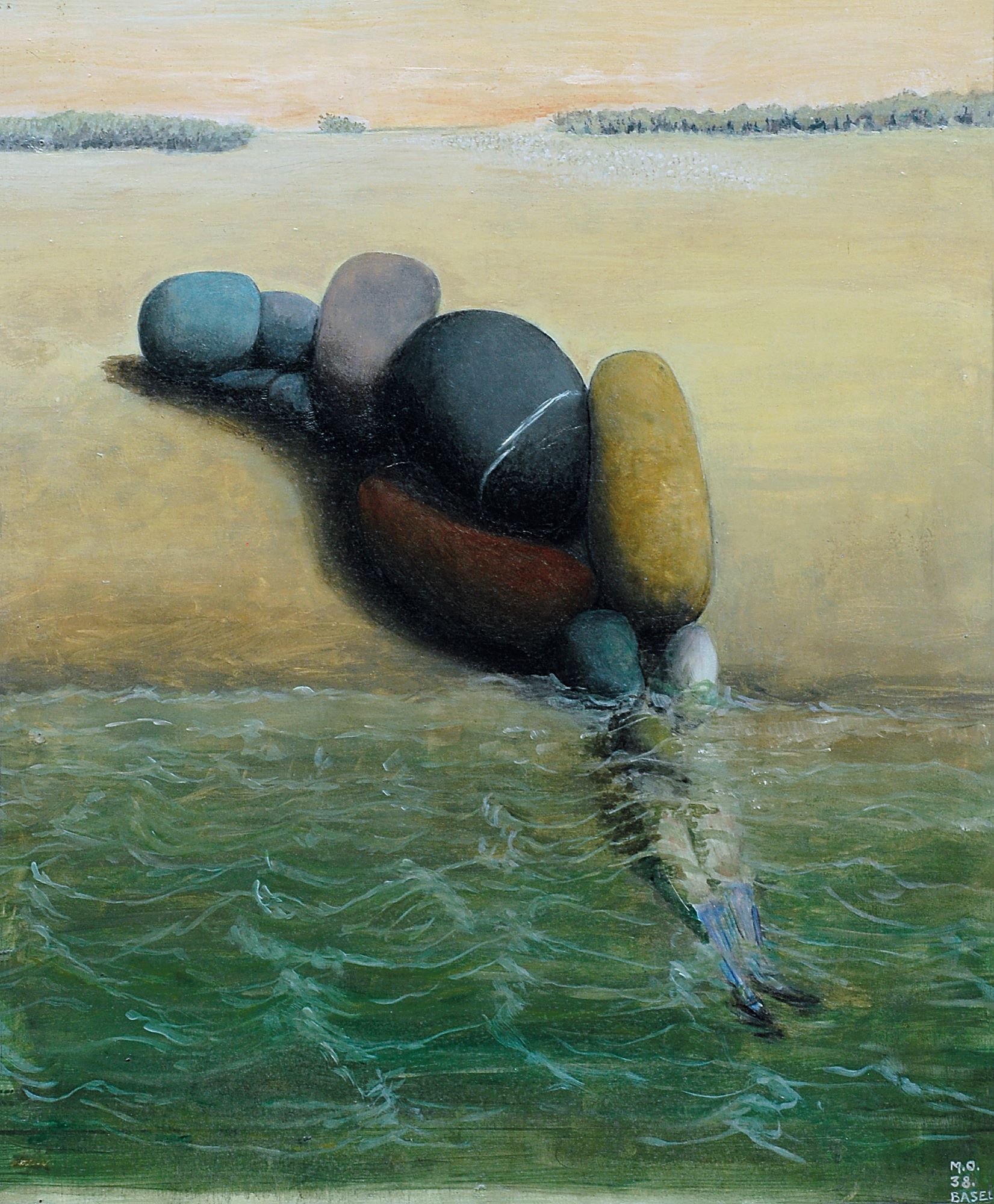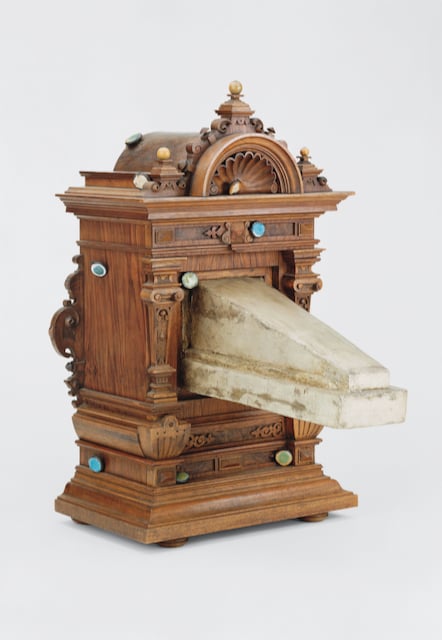

Installation view of Meret Oppenheim: My Exhibition, on view at The Museum of Modern Art, New York through March 4. Photo: Jonathan Muzikar.
It’s hard to know how many poetic young women with some Jewish history in their background came to Paris in the late 1920s or early 1930s. Aspiring painters, writers or flappers, they wanted to be free from the constraints of a childhood that had been overshadowed by the horrors of World War I and the menacing instability of its aftermath. Many of them had small allowances sent by liberal-minded, hopeful and attentive parents, and this helped them stay afloat in the Bohemian quarters they were drawn to. As the notable Berlin-born, Swiss artist Meret Oppenheim remembered, the motto was: “Late to bed, late to rise, lots of alcohol.”
In 1930, when she was just 16 years old and living in Switzerland, Meret Oppenheim decided she’d had enough of school and presented her parents with a drawing that included an equation. To the left of the equal sign she wrote “x.” On the right, she drew a picture of a rabbit. The meaning was clear—she was finished with mathematics and the bourgeois expectations of her milieu. Her goal was to become an artist, and the Paris of Montparnasse was to be the catalyst.
Astonishingly, Oppenheim achieved her aim almost immediately, participating in her first art exhibition with the Surrealists at the Salon des Surindépendants in the Spring of 1933. Exhibits in London, New York and Basel soon followed. In 1936, Alfred Barr, director of the Museum of Modern Art in New York City (MoMA), purchased her most famous work, a fur-lined teacup that had caused a stir in London, New York, Philadelphia, San Francisco and Boston. He paid her fifty dollars for the beguiling object—something mineral that, as if by magic, had been turned into something animal. Nonetheless, the audaciously inventive artist’s first North American retrospective, My Exhibition, only occurred this year, coming first to the Menil Collection in Houston and now to MoMA, where it will be on view through March 4. The show includes more than 180 paintings, drawings, sculptures and collages, demonstrating the daredevil freedom that propelled Oppenheim from Switzerland to Paris in her youth, as well as the obdurate determination that characterized the second part of her career.

Meret Oppenheim. New Stars (Neue Sterne). 1977–82. Oil on canvas. Kunstmuseum Bern. Meret Oppenheim Bequest.
Meret Elizabeth Oppenheim was born into an intellectual family in the Charlottenburg district of Berlin in 1913. Her father, Erich Oppenheim, Jewish by descent but non-practicing and unaffiliated, was a physician who was highly influenced by Swiss psychiatrist Carl Jung. When he was called into the German army at the start of World War I, his Christian wife moved the family to her parents’ home in Switzerland. The beauty of the Swiss landscape and the vibrant artistic circle that surrounded Meret’s maternal grandmother—a children’s book author and illustrator, as well as, in the spirit of the age, a reader of Tarot cards—had a great effect on Meret and her two siblings. In Switzerland, Meret came to know many cultural figures, including the author Hermann Hesse, who was married to her mother’s sister for a short time, and the Dadaist Hugo Ball.
After the war, when the family was reunited, they moved to a small mill town in Southern Germany. Her father returned to his medical practice, and they continued to go often to Switzerland, at first traveling so that her father could attend Jung’s seminars and later because of the mounting political tensions. Over the years, the children attended many different schools; one of them, a Rudolf Steiner school, celebrated spirit, soul and body through the introduction of fairy tales and folk stories, and these inspired Meret to create fantastical drawings, which her supportive mother retained. During several periods of childhood and adolescent despair, Meret began to record her dreams and thoughts in notebooks, which are now a rich source for biographers and art historians.
With permission from her parents, in May 1932, Meret and a slightly older girlfriend boarded a train in Basel headed for Paris. In their high spirits, the girls got a little tipsy on Pernod. Meret recorded the moment of arrival in her notebook (translated from the German by writer and performer Kathleen Heil, whose translation of Meret Oppenheim’s poems will be published later this year):
Freedom!
Finally!
The harpoons fly
A rainbow encamps on the streets
Undermined only by the distant buzz of giant bees.
Already thinking in dream images similar to those of the French symbolist poets Paul Verlaine and Arthur Rimbaud, Oppenheim quickly became fluent in the vocabulary of the Surrealists and experienced a thrilling synergy in her new city—“…not like somebody that had come from Switzerland to Paris,” she mused, “but as if I had been created there!” Although she had once thought of herself as shy, Oppenheim was suddenly renowned for her boyish beauty, lack of inhibition and creative freedom. At Café du Dôme, she met Alberto Giacometti, who was also from Switzerland, and he introduced her to artists Hans Arp and Sophie Taeuber-Arp; from there, she became acquainted with the whole circle of Surrealists surrounding writer and poet André Breton.

Meret Oppenheim. Stone Woman (Steinfrau). 1938. Oil on cardboard. Private collection.
For a short time, she went to art school, but for the most part she worked from her small rented room at the Hôtel Odessa, sleeping all day and staying up all night. Her drawings and paintings were filled with images and shapes taken from dreams and daydreams, and they sometimes included such enigmatic text as: “I am Justice with the Little Brick Skirt” or “Alaska the Beautiful.” Later she began experimenting with materials, for example affixing sugared almonds to a board she sawed into something that looked like a face. In 1933, artist Man Ray photographed her in a series of nude poses taken behind the flywheel of a printing press. With her hair cut mannishly short and ink covering the palm of her hand and forearm, her androgynous image, as it was reproduced in the Surrealist journal Minotaure, became one of the emblems of the Surrealist movement. At about the same time, she had a passionate love affair with painter Max Ernst, and one of her most lively and evocative works from this period, Quick, Quick, the Most Beautiful Vowel Is Voiding, was dedicated to him.
Oppenheim’s great burst of creativity was happening while she was at the cusp of adulthood, not entirely aware of how she was changing or the way the fragile world around her was changing as well. When she was a small child, she had drawn a vibrant picture of a happy girl, arms spread out, pausing halfway up the steps of a ladder. The drawing is dated “18/III 19” (March 18, 1919) and identified in an adult’s handwriting as “Cinderella Standing on a Ladder.” The image is an apt emblem for both her exhilaration and the precariousness of her Paris years. According to her niece, Lisa Wenger, letters home from those days show Oppenheim worrying “because of that stuff in Germany,” and she asks, “Is it like Berlin—horrible like that? Is Papa still able to work or does nobody come any more?” Like the little girl on the ladder, she had climbed rather high and wasn’t entirely aware of how scant the supporting structure beneath her was. In fact, her mother had to leave Germany in 1935, when someone noticed her spit on a framed photograph of Adolf Hitler hanging in a shop and a friend warned that it was unsafe for her to remain. Her father stayed until 1936, when it became illegal for him to practice medicine because of his Jewish roots. As an immigrant in Switzerland, however, he wasn’t allowed to practice medicine there either, and the family’s financial situation became dire.

Meret Oppenheim. Object (Objet). 1936. Fur-covered cup, saucer, and spoon. The Museum of Modern Art, New York. Purchase.
The story of the fur-lined teacup says a great deal about the social nature of Oppenheim’s early creativity and youthful originality. In order to stay afloat in Paris, she had begun working for fashion designers such as Elsa Schiaparelli, making what she called “fantasy jewelry,” including a bangle bracelet with sealskin glued to the outer surface of the wide copper band. One afternoon she wore a sample to Café de Flore, where she was meeting her friend Dora Maar, who had come with Picasso. Picasso admired the bracelet, praising her inventiveness. “You could cover anything with fur,” he said. Oppenheim jokingly replied, “Yes, this saucer, this cup…Imagine,” she went on, “drinking thick hot chocolate out of it.” Not long after, Breton invited her to participate in an exhibition at the Ratton Gallery, and the idea for the fur teacup returned to her. Immediately, she purchased an inexpensive cup, saucer and spoon and lined each with strips of the pelt of a Chinese gazelle that she had previously purchased. By applying the fur to ordinary and useful objects, she altered something fundamental and the transformation was instantaneous—the way things change in dreams or fairy tales. If there was a sexually perverse component to the art object, it was counterbalanced by the youthfulness and simplicity of its maker.

Meret Oppenheim. X-Ray of M.O.’s Skull (Röntgenaufnahme des Schädels M.O.). 1964/1981. Gelatin silver print. 15 15/16 x 12 in. (40.5 x 30.5 cm). Edition 6/20. Hermann and Margrit Rupf Foundation. Kunstmuseum Bern.
Even during her early Paris years, Oppenheim had bouts of depression like the ones she had experienced during childhood, but these intensified starting in 1937, when the situation throughout Europe was unraveling and her family could no longer support her financially. Midway through the year, she returned to Switzerland. After that, she visited Paris only occasionally before the Nazi occupation made it impossible to travel at all.
For 17 years, between 1937 and 1954, she suffered a psychological and artistic crisis, questioning everything she had ever made and wondering if she could again achieve the success that had come from her fur-lined teacup. When she began to heal, experiencing a second surge of creative energy, she took a studio in Bern, which became her creative base. She worked there for the rest of her life, producing art with diverse materials ranging from slate to cotton, wool to a beer glass, experimenting in all possible media. As with the artist Louise Bourgeois, the shape and appearance of her artwork was mercurial, but she was always searching. Sometimes she painted archetypal clouds or mountains; sometimes she produced enigmatic objects such as Animal Headed Demon, made from the emptied-out case of a neoclassical clock decorated with ceramic buttons and a wedge of silver-coated wood that formed a bird’s beak. Sometimes her work was haunting, like X-Ray of M.O’s Skull. This later work is thoughtful and well executed, but the spontaneity of her charismatic youth has faded, replaced by greater technical and conceptual control.

Meret Oppenheim. Animal-Headed Demon (Tierköpfiger Dämon). 1961. Private collection. © 2022 Artists Rights Society (ARS), New York / Pro Litteris, Zurich.
In her mind, the creation of the teacup marked a division between the two parts of her career, and it came to symbolize both the productivity of her early years and the sometimes-obstructed path that followed. The possibility of regaining the fame of her Paris days gradually diminished. Surrealism was superseded by American Abstract Expressionism in the postwar world, and interest in Oppenheim’s great subjects, transformation and dream consciousness, receded.
In 1983, two years before she died, Oppenheim sketched out the plan for a self-curated exhibition that would demonstrate continuity in her art, from childhood drawings to the late paintings of floating stars. She did this with miniature pictures of her artwork, drawn with colored pencils on 12 sheets of paper. She called it “My Exhibition,” and that is the show now at MoMA. There’s a lot to think about as you move from the small childhood watercolors to the enormous later sculptures such as Octavia, which was made from what looks like a log combined with a saw and stands as tall as a basketball player. A poignant feeling circulates through the retrospective, which is both about achievement and loss, and one can’t help but think about the optimistic image of “Cinderella Standing on a Ladder,” Meret Oppenheim’s fragile avatar.
